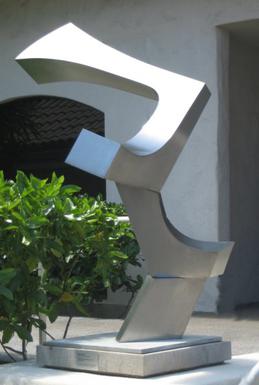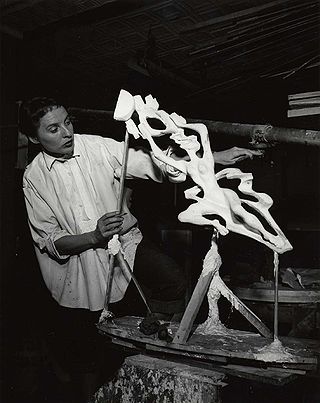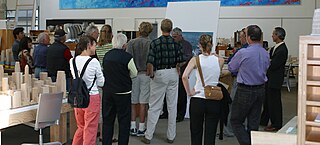
George Warren Rickey was an American kinetic sculptor known for geometric abstractions, often large-scale, engineered to move in response to air currents.

Peter Voulkos was an American artist of Greek descent. He is known for his abstract expressionist ceramic sculptures, which crossed the traditional divide between ceramic crafts and fine art. He established the ceramics department at the Los Angeles County Art Institute and at UC Berkeley.

George Segal was an American painter and sculptor associated with the pop art movement. He was presented with the United States National Medal of Arts in 1999.

The Honolulu Museum of Art is an art museum in Honolulu, Hawaiʻi. The museum is the largest of its kind in the state, and was founded in 1922 by Anna Rice Cooke. The museum has one of the largest single collections of Asian and Pan-Pacific art in the United States, and since its official opening on April 8, 1927, its collections have grown to more than 55,000 works of art.
Jim Perry is an American sculptor. He received a BA in sculpture from Bard College. He began his sculpture career in the early 1970s in New York City where he exhibited extensively and, in 1975, was included in the Whitney Biennial.
The Honolulu Museum of Art Spalding House, formerly The Contemporary Museum, Honolulu, was integrated into the Honolulu Museum of Art under this name. It was the only museum in the state of Hawaii devoted exclusively to contemporary art. The Contemporary Museum had two venues: in residential Honolulu at the historic Spalding House, and downtown Honolulu at First Hawaiian Center. All venues continue to be open to the public.
Toshiko Takaezu was an American ceramic artist, painter, sculptor, and educator whose oeuvre spanned a wide range of mediums, including ceramics, weavings, bronzes, and paintings. She is noted for her pioneering work in ceramics and has played an important role in the international revival of interest in the ceramic arts. Takaezu was known for her rounded, closed ceramic forms which broke from traditions of clay as a medium for functional objects. Instead she explored clay's potential for aesthetic expression, taking on Abstract Expressionist concepts in a manner that places her work in the realm of postwar abstractionism. She is of Japanese descent and from Pepeeko, Hawaii.
Mary Frank is a British and American visual artist who works as a sculptor, painter, printmaker, draftswoman, and illustrator.

James Rosati was an American abstract sculptor. He is best known for creating an outdoor sculpture in New York: a stainless steel Ideogram that was located in the World Trade Center Plaza.
Bob Justin (1941–2015) was an American outsider artist from New Jersey. After being forced into retirement in 1991 by illness, he began to liquidate an old tool collection and other property at local flea markets. During this time he returned to a childhood penchant for finding imagery in everyday objects. By combining various antique found objects, or what he called the refuse of society, he would create what he calls “critters”, animal or human faces or forms set forth in found object wall masks or standing sculptures.
The Honolulu Museum of Art Spalding House, formerly The Contemporary Museum, Honolulu, was integrated into the Honolulu Museum of Art under this name. It was the only museum in the state of Hawaii devoted exclusively to contemporary art. The Contemporary Museum had two venues: in residential Honolulu at the historic Spalding House, and downtown Honolulu at First Hawaiian Center. All venues continue to be open to the public.

Satoru Abe is a Japanese American sculptor and painter.
Charles Arthur Arnoldi is an American painter, sculptor and printmaker.

William Thomas Wiley was an American artist. His work spanned a broad range of media including drawing, painting, sculpture, film, performance, and pinball. At least some of Wiley's work has been referred to as funk art.

Gwen Lux Creighton, professionally Gwen Lux, (1908–1986) was an American sculptor known for her abstraction and frequently constructed from polyester resin concrete and metals. She was among America's pioneer women sculptors.

Nick Cave is an American sculptor, dancer, performance artist, and professor. He is best known for his Soundsuit series: wearable assemblage fabric sculptures that are bright, whimsical, and other-worldly, often made with found objects. He also trained as a dancer with Alvin Ailey and often incorporates dance and performance into his works. His later sculptures have focused on color theory and included mixed media and large-scale installations. He lives in Chicago, Illinois, and directs the graduate fashion program at the School of the Art Institute of Chicago. He continues to work on Soundsuits as well as works completed as a sculptor, dancer, and performance artist.

Peter Alexander was an American artist who was part of the Light and Space artistic movement in southern California in the 1960s. He is notable for his resin sculptures from the 1960s and 1970s.

Spalding House, also known as the Cooke-Spalding House was an art museum and sculpture garden in Honolulu, Hawaii. It was called Nuumealani by Anna Rice Cooke, who commissioned it. The house and gardens constituted a 3+1⁄2-acre former art museum in the Makiki Heights district of Honolulu.

Ronald Bladen was a Canadian-born American painter and sculptor. He is particularly known for his large-scale sculptures. His artistic stance, was influenced by European Constructivism, American Hard-Edge Painting, and sculptors such as Isamu Noguchi and David Smith. Bladen in turn had stimulating effect on a circle of younger artists including Carl Andre, Donald Judd, Sol LeWitt and others, who repeatedly referred to him as one of the 'father figures' of Minimal Art.

Kenneth Richard Ferguson was an American ceramist.











